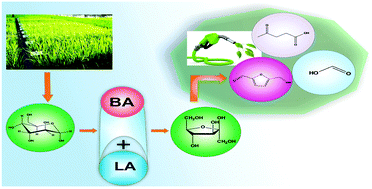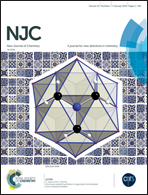Hydrothermal conversion of glucose to levulinic acid using multifunctional ionic liquids: effects of metal ion co-catalysts on the product yield
Abstract
Efficient conversion of glucose to levulinic acid (LA) was achieved with –SO3H functionalized ionic liquids in combination with a catalytic amount of metal salts under environmentally benign mild reaction conditions. Ionic liquids having different Bronsted acidic functional groups were prepared in the laboratory. The acidity of these ionic liquids was determined on the basis of the Hammett acidity function using UV-Visible spectroscopy. These catalysts were then screened in the conversion of glucose to LA using a batch autoclave under autogenous pressure at a temperature range of 140 to 175 °C. The structure–activity relationship of these multifunctional ionic liquids was correlated based on the Hammett function (Ho) and the catalytic activity results obtained in terms of glucose conversion and LA yield. The catalytic activity of the functionalized ionic liquids decreased in the order: IL-SO3H > IL-COOH > IL-OH, which is in good agreement with their Bronsted acidity trends. Furthermore, a metal salt based Lewis acidic co-catalyst, with metal ions (Fe, Co, Ni, Cu and Zn), was used in combination with the laboratory prepared Bronsted acidic functionalized ionic liquids in the efficient conversion of glucose to LA. Among all the investigated catalyst and co-catalyst systems, the –SO3H functionalized ionic liquid with nickel sulfate (NiSO4·6H2O) showed the highest LA yield (56.33%) and selectivity (56.37%). The synergistic effect of the metal ions helps in improving the LA yield by 10% as observed in our investigations. The co-catalytic effect of the transition metal chlorides and metal nitrates was not obvious as compared to transition metal sulfates. The catalyst could be recovered easily and reused three times without significant loss of activity.



 Please wait while we load your content...
Please wait while we load your content...